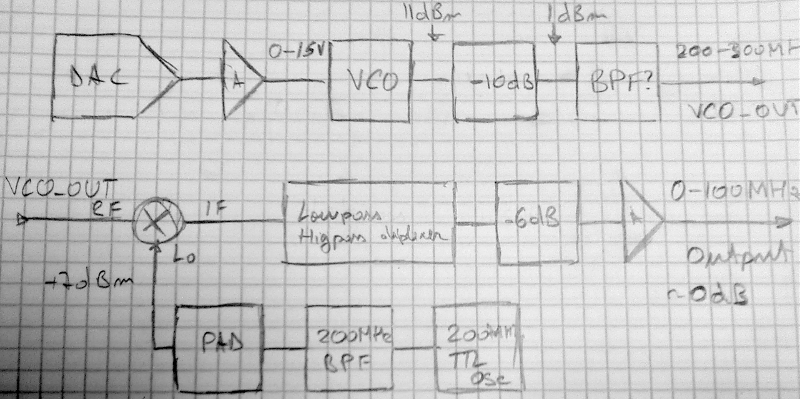Hello
I've been playing with RF for some time and i'm starting to feel the need for some basic tools: a way to graph filter, amplifier response, etc.
I have a good signal generator but it's very slow and i can't connect it to a PC.
Checking a few points are ok - dial in frequency, look at VRMS on a scope then convert to dBm.
I've seen some AD8302 (
http://www.analog.com/media/en/technical-documentation/data-sheets/AD8302.pdf ) modules that output gain and phase difference.
I also need an oscillator that can cover ~ 1-100MHz.
The first idea is to use a DDS chip - but they are quite expensive.
After looking around the net ( and at my other signal generator schematics ) I've decided to use the following architecture, with some changes - see the description below.

- a very good DAC - 0-15V will cover 195 - 315MHz -> 16 bits will have 27.5kHz steps, 24 bits will lead to 107Hz steps
- DAC amplifier - extend DAC range to 0-15V
- VCO: V200ML01 200-300MHz,
http://pdf.datasheetcatalog.com/datasheet/Zcommunications/mXrwuxs.pdf -10dBm pad, as specified in
http://www.zcomm.com/wp-content/uploads/2014/06/AN-102.pdfband pass filter - 200-300MHz ? is it required ?
- should I add an amplifier as well ? I can't test a diy 200-300MHz amplifier, and if I add a MMIC I'll have to reduce the output power again so I do not overload the mixer
- 200MHz TTL oscillator - square wave
- 200MHz low pass or a narrow band pass filter, so I will not mix higher harmonics
- a pad or buffer to get the signal to ~7dBm for the mixer LO drive
- high pass / low-pass diplexer, at 100MHz to properly terminate the mixer
- attenuator and power splitter, to split the signal 2 ways
- 2 amplifiers, one for the normal output and one for the reference output
- a AD8302 module
- a decent ADC - 12 bits should be enough
For the software - something PC based or get a small A20 board and a compatible LCD to make a stand-alone unit.
Is there anything that I forgot ?